Nokia Lumia 710 Review
Nokia Lumia 710
Can Nokia's budget Windows Phone 7 handset steal the show?
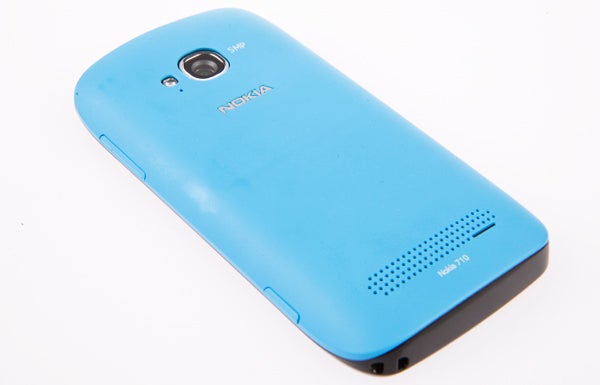
Verdict
Pros
- Decent screen
- Slick Windows Phone OS
- Well built
Cons
- No microSD card slot
- Poor button ergonomics
- Poorly stocked app store
Key Specifications
- Review Price: £270.00
- 3.7in TFT LCD 480 x 800 display
- Windows Phone 7.5
- 1.4GHz single-core processor with 512MB RAM
- 8GB storage
- 5 megapixel camera with 720p video
In terms of design the Lumia 710 was always going to lose out when compared to the strikingly beautiful Lumia 800. The 800 took Nokia phones in a new direction with a smooth, seamless design coupled with a curved glass screen. Simple, clean and gorgeous.
The 710 on the other hand shows traces of the Finnish company’s history and echoes the design of Symbian phones from a couple of years ago, such as the C7. The 710 features the same size screen as the 800, but instead of the unbroken smooth lines on the former, the 710’s Gorilla Glass front is broken by rather large, and certainly ugly, physical buttons.
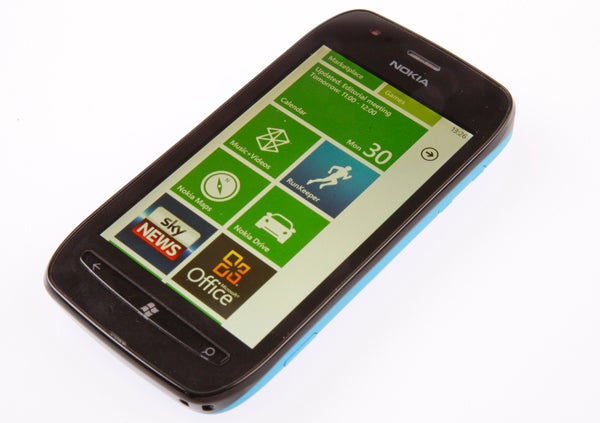
These buttons, (back, home and search) are compulsory on all Windows phones but most devices integrate them into the screen as capacitive buttons, or at least use more stylish physical ones. The backlit buttons here are just one large button which actually has a nice action and the three functions are distinct enough not to cause confusion, but it’s still not a very elegant solution.
Another issue with the front of the screen is a slight millimetre-high bezel running around the edge of the screen. With Windows Phone 7 utilising a swiping action in almost all its menus, this bezel does nothing to help the smoothness of operation and at times is really irritating.
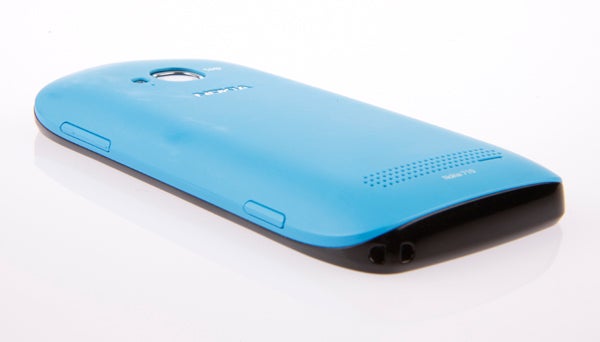
The screen surround and part of the side of the phone is made of glossy black plastic (a white version is also available). While we would have preferred the polycarbonate matt plastic like the 800, it doesn’t look too bad. On the rear you’ll find a replaceable plastic cover which was cyan in our review sample. The matt finish is lovely and gave the phone a premium feel you don’t get with the likes of the HTC Radar – this matt finish is much nicer than the glossy white version we first saw.
The phone normally comes with a black or white backplate to match the front, along with two extra ones in the box (cyan, magenta or yellow) and although personalising your phone in this way is not a top priority for most, it’s still a nice extra and in this case adds to the look and feel of the phone. On the back, you’ll find the five megapixel camera along with single LED flash, as well as the phone’s speaker grille.
The phone slopes from front to back meaning the all the sides are
slightly angled and this throws up problems for the buttons located
there. On the right edge you’ll find a volume rocker up top as well as
the required (by Microsoft) physical shutter button for the camera.
While these are located sensibly at the top and bottom of the right
edge, because of the sloping sides, they are not the easiest to press
and on a number of occasions our fingers slipped while trying to press them –
especially the volume buttons.

On the top you’ll find the
power/screen lock button, which is also awkward to press, along with the
headphone jack and microUSB port. Unlike the 800, the battery in the
710 is replaceable by simply removing the back cover. Lifting out the
battery will give you access to the SIM card slot (the 710 like the 800
uses a micro-SIM). While some people would rather have easier access to
the SIM card slot, for most users this won’t be a problem.
As with
all Windows Phones, there is no way of expanding the memory, such as
with a microSD card, and with only 8GB of storage on board (only 6.28GB of
which is accessible) this could be a problem for those looking to use
the phone as their main MP3 player, not to mention if you want to cram it full of apps, movies and
photos. You do get 25GB of cloud storage with SkyDrive though.
Overall
the phone feels really nice in the hand, with the matt back making it
feel a lot more premium that it initially looks. It’s slightly bigger
than the 800 with a footprint of 119 x 62.4 and a thickness of 12.5mm, which
is considerably more than phones like the Motorola Droid Razr and the iPhone 4S, but thanks to the tapered edges, you don’t notice the extra bulk.
Also
helping this is the lightness of the phone, weighing just 126g compared
to 142g of the 800 and 137g of the iPhone. Unfortunately the ugly
physical buttons and bevelled screen edge detract from what is otherwise
a perfectly nice phone.
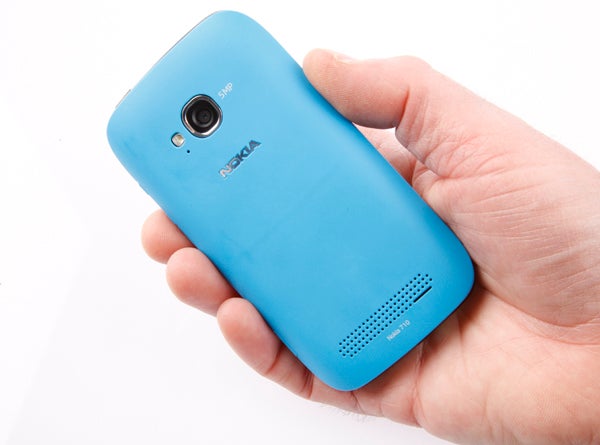
Looking at the screen, Nokia has decided to use the less expensive and more battery intensive TFT LCD screen technology most commonly seen on mid-to-low range handsets. However one advantage the Nokia 710 has over these other devices is the addition of Nokia’s own ClearBlack technology. ClearBlack is a proprietary technology from Nokia which aims to ensure that the blacks you see really are black, helping the contrast of the screen. ClearBlack also aims to reduce reflections, help viewing angles and improve outdoor use.
And it seems to work. While the screen on the 710 is no where near as vibrant as the AMOLED screen seen on the 800 (as you would expect), it is a step up from run-of-the-mill TFT screens we’ve seen on the likes of the ZTE Tania.
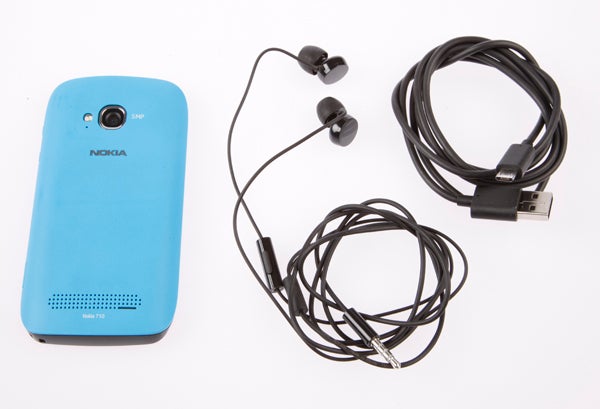
Viewing angles are not flawless by any means and you do get something of a blue tinge when not looking directly at the screen, however they are better than normal and since for the most part you’ll be looking directly at your phone anyway, we don’t see it as much of a problem. Also the colour temperature of the handset is relatively balanced with
colours not getting over saturated as they tend to in AMOLED displays.
The Windows Phone 7 interface, especially when using the black background, helps the look with the large blocks of colour on the Live Tiles looking bright, though not particularly vibrant. Annoyingly, brightness settings are limited to low, medium and high and when the auto setting is on, it can lead to the phone’s brightness not really suiting the conditions.
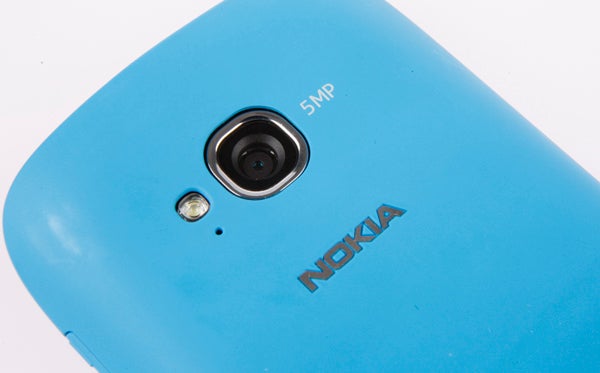
The TFT LCD is very clear when viewing webpages with text appearing sharp even when zoomed right in. Despite having the same low resolution of 480 x 800 as the Lumia 800, it doesn’t suffer from the issues related to the PenTile RGBG subpixel matrix of that screen, which makes text appear grainy – especially in non-mobile optimised sites.
The Windows Phone 7 interface is very much different from the likes of Android and iOS and looks and works almost identically across all devices, independent of the hardware. Indeed because of the strictures Microsoft imposes on manufacturers it means the interface is slick and works very well no matter what handset you buy.
Unlocking the phone, you are faced with the Live Tile interface which aims to put the most important information at your fingertips. Not only is the interface customisable, letting you pin pretty much anything (apps, websites, contacts) to the home page (up to 250 tiles if you must know), but it also brings you notifications within the tiles themselves, letting you know when you’ve got email, missed calls or unread messages.
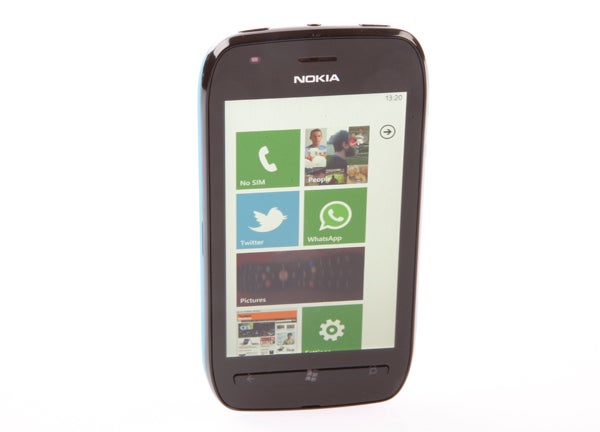
This is a much slicker solution than the notification menus in iOS and Android which requires a pull down from the top of the screen in both versions. As we said earlier, swiping left and right is integral to navigating around WP7 and while this is a nice idea, it doesn’t always work. At times you find yourself swiping left when you should be pressing the back button and vice versa. It’s not a major inconvenience, but this lack of uniformity can be frustrating.
The WP7 Marketplace currently has around 50,000 apps which is a decent start considering the platform is so young, but compared to the app stores of iOS and Android, it is still miles behind. While most of the major apps are available, there are some notable exceptions such as Dropbox, Instagram, BBC iPlayer and of course Skype. All of these, with the exception of iPlayer are said to be in the works however.
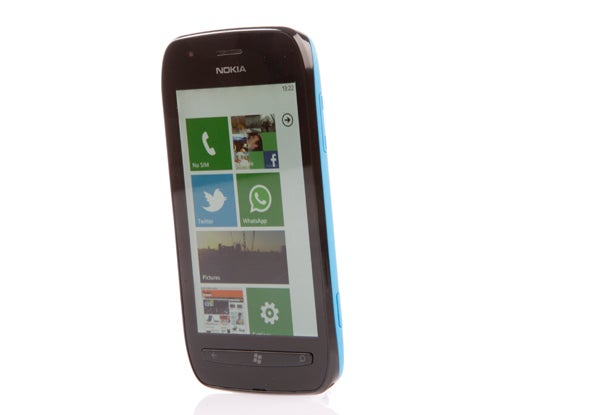
There are also problems with some of the apps that are available, most notably the official Twitter app, which is just pants in our opinion but without a viable alternative available in the Marketplace, we’re stuck with it. One major positive for the Marketplace however is the ability to try any app before committing to purchase it, albeit in a limited manner, which is a feature that Android and iOS could well do with implementing.
Because this is a Nokia handset, you do get a number of apps which are exclusive (for the moment) to their phones. First up is Nokia Drive, which is a turn-by-turn navigation app which does a decent job of replacing a standalone SatNav. It includes maps of Africa, America, Europe, Asia / Middle East and Australia / New Zealand which can be downloaded prior to setting off on any trip. However the app does lack certain features, most notably traffic updates and multi-waypoint routing – but considering it’s free, we can’t really complain.
Next up is Nokia Music, which is similar in a lot of ways to the main WP7 music app but offers one extra in the shape of Mix Radio, which is an excellent addition. Mix Radio gives you free access to hour-long playlists of a large variety of music genres and recent releases. These can be downloaded while on Wi-Fi for listening while offline and you can store up to four of these offline playlists at any one time on your phone.

While the playlists themselves won’t please any serious music fans out there with them erring on the side of generic, but they do offer a way of instantly having access to a huge library and variety of music you’re otherwise unlikely to have. You can skip through any tracks you don’t like, but be warned this is only up to a maximum of six skips per hour, as a result of some “tricky licensing radio rules”, and you can’t see what tracks are coming. Also we found that some of the playlists didn’t make much sense, such as finding Don’t Cry For Me, Argentina, in the 70s Rock playlist or The Waterboys in New Releases. But despite these flaws Mix Radio is a big addition to the Lumia range and will help make the 710 stand out against other budget competitors.
Other than Mix Radio, the Nokia Music app gives you access to an MP3 store (with a decent choice of music), your own music of course and a neat feature which uses your location to show what gigs are taking place near you.
Of course the inclusion of a Microsoft Office app is again an area where WP7 stands apart from iOS and Android and for those looking to edit, create or share documents on the go, this might be a big selling point. The app works well on the Lumia 710 as you would expect with the LCD screen making it easy to see text. Third party apps from eBay, ESPN, Sky News, Groupon and Trip Advisor come pre-loaded too.
Like the Lumia 800, the 710 is powered by a 1.4GHz Snapdragon processor which is only single core. And you do notice the lack of an extra core when you compare the performance of the 710 against today’s high-end Android devices or the iPhone 4S. While navigating the WP7 menus is slick and has obviously been optimised to work with single-core processors, when you begin opening a number of apps and trying to switch between them, you do get a noticeable lag. This is not helped by the fact that you only get 512MB of RAM which doesn’t help multitasking any.
Browsing the Internet is relatively pain free with the Internet Explorer app loading webpages quickly and with pinch-to-zoom very smooth and webpages rendering as they should, thanks to hardware graphic acceleration. – though there is no Flash support. The neat and simple interface means you don’t waste screen space with unnecessary clutter. The address bar on the bottom of the screen, which doubles as a search bar, and a refresh button are the only on-screen icons.
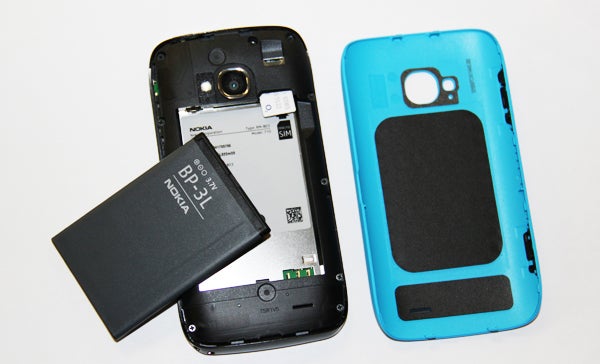
Looking at the camera, the snapper on the back features a modest five megapixel sensor but does at least have a relatively fast f2.4 wide-angle (28mm) lens which helps a little to make the most of what that sensor can offer. The camera is nothing to write home about but performed decently in most conditions. Outdoor results were okay, but like the 800 dark areas are underexposed. Images tended to come out a little soft which will happen if you fail to hold the phone perfectly steady when pressing the shutter button.
Speaking of which, the physical shutter button is a big bonus point on any phone, and we commend Microsoft making it a prerequisite on any phone – however as we said previously, it’s not the most comfortable to press on this phone due to poor ergonomics. Pressing the button at any time, even when the phone is locked, will bring you directly to the camera app. While this is a great feature, it can at times see you taking inside-of-the-pocket pictures inadvertently. There is an option which prevents the shutter key from starting the camera if the proximity sensor is triggered.
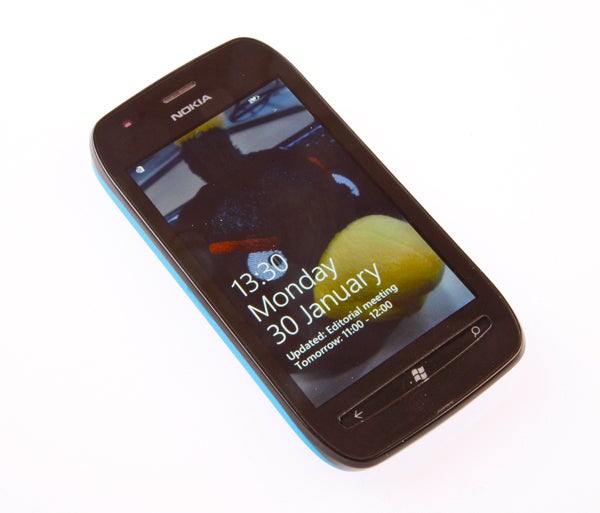
The camera app itself is pretty decent letting you tweak a good range of settings including white balance, contrast, saturation, sharpness and ISO, as well as letting you touch the screen to focus on something which may not be in the centre of the screen. The app processes the pictures very quickly and there is also a wizard to clean up your snaps on the phone before sharing them. All photos will be automatically saved to your 25GB SkyDrive account but this option can be disabled.
Sample Camera Images
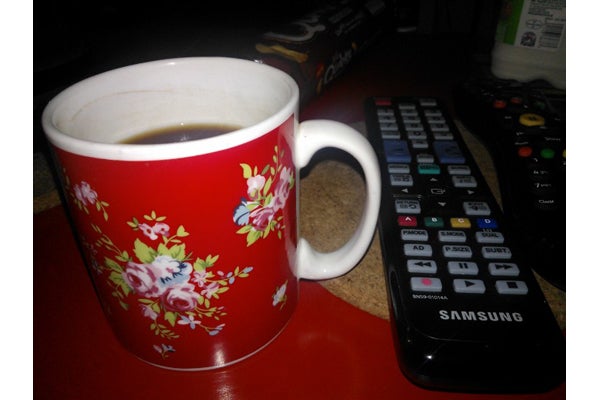
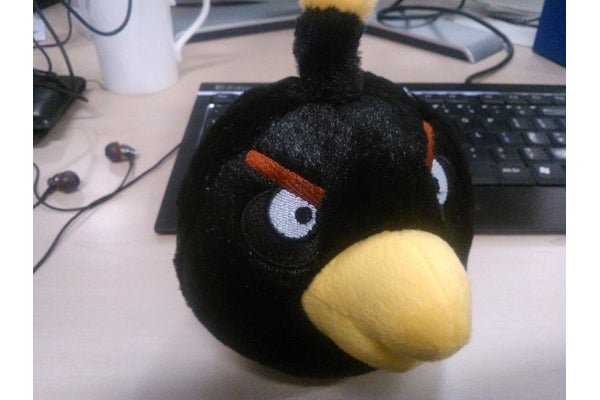
One point to note is that the default setting when you get the phone for focus mode is macro and for most pictures this should be changed to normal. The phone is capable of shooting 720p video at 30fps and in our tests, it handled video capture reasonably well considering this is a budget handset. While anything more than gentle panning will cause a bit of blur, the video, even when displayed on a large screen, still looked pretty decent.
Turning to the phone’s ability to handle calls, it performed well in most of the conditions we tested it in. Indoors, voices were clear and we even found that it had a markedly better reception than our iPhone 4 when in the same location. We never had to boost the volume to much to hear the person on the other end, even when they were outdoors. The speaker, located on the back of the phone, is as you would expect pretty poor. While it offers enough volume, the sound coming from it is distorted and pretty tinny.
One of the areas where the Lumia 710 is let down is the battery. While the 1,300mAh battery is replaceable, we barely managed to get a day of moderate use out of it on a full charge. This is a disappointment considering some smartphone batteries are finally getting their act together and giving you up to two full days of use nowadays.
Managing you phone and connecting to a PC is another pain, but one common to all Windows Phone handsets, because you have to use Microsoft’s Zune software in a similar way that iPhone users have to use iTunes. This means that instead of simply dragging and dropping files onto your phone, you have to download the software, install it and use the rather clunky interface if you want to transfer music or movies to your phone. Not good, especially as Zune isn’t even the default media player on Windows, unlike the way iTunes is for Macs.
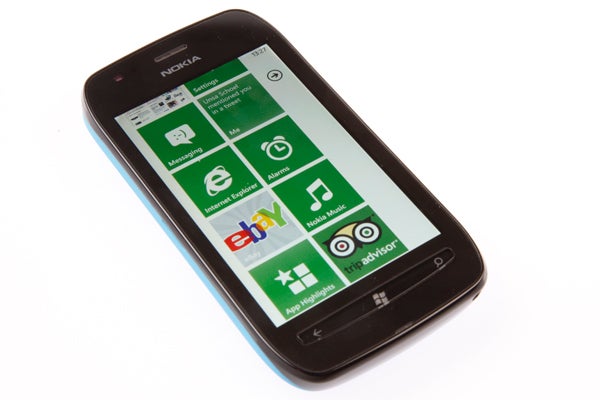
Finally we come to the question of value, which in a phone of this level is one of the most important considerations. At the time of publishing this review, Nokia had not released official pricing for the Lumia 710 making it difficult to gauge exactly the value score for the handset.
However, it is expected to be priced in or around £250 SIM-free and certain networks are offering it on pre-order for free on a £20-a-month contract but considering you can get the Lumia 800 for free on the same contract, we don’t see this as particularly good value.
This is a phone which will be competing against the likes of the HTC Radar which cost £330 at launch and the soon-to-be-released ZTE Tania which is currently available for pre-order also for £250. We think that if the Lumia 710 does come out at £250 or preferably a bit closer to £200 it represents very good value.
Verdict
The Nokia Lumia 710 could have been the first budget Windows Phone handset to attract users in large numbers, but the inherent limitations placed on Nokia by Microsoft, along with a couple of poor design choices mean it falls just short of being a great budget handset. However, if Nokia gets the pricing right, it could represent great value for money for those looking to take their first step on the Windows Phone 7 platform.
How we test phones
We test every mobile phone we review thoroughly. We use industry standard tests to compare features properly and we use the phone as our main device over the review period. We’ll always tell you what we find and we never, ever, accept money to review a product.
Trusted Score
Score in detail
-
Performance 7
-
Camera 7
-
Design 7
-
Usability 8
-
Value 8
-
Features 8
General
| Operating System | Windows Phone |
| Height (Millimeter) | 119mm |
| Width (Millimeter) | 62.4mm |
| Depth (Millimeter) | 12.5mm |
| Weight (Gram) | 126g |
| Available Colours | White, Black front + white, black, cyan, fushia and yellow backs |
Display
| Screen Size (inches) (Inch) | 3.7in |
| Screen Resolution | 480 x 800 |
| Touchscreen | Yes |
Storage
| Internal Storage (Gigabyte) | 8GB |
| Camera (Megapixel) | 5 Megapixel |
| Front Facing Camera (Megapixel) | No Megapixel |
| Camera Flash | 1 x LED |
Connectivity
| Bluetooth | Yes |
| WiFi | Yes |
| 3G/4G | Yes |
| 3.5mm Headphone Jack | Yes |
| Charging/Computer Connection | microUSB |
Processor and Internal Specs
| CPU | 1.4GHz Qualcomm Snapdragon |
Misc
| App Store | Yes |
| GPS | Yes |

